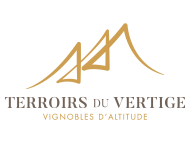The Vineyard
The turbulent tectonic activity of the region explains the coexistence of layers from different periods of earth life. Our vineyard situated at an altitude of between 150 and 500 metres is characterized by long cycles which give time to the expression of aromas. The climate of Hautes Corbières is dry, sunny and warm. This terroir benefits from the natural protection provided by the mountains which create a very specific climate, of which we are the only beneficiaries: a continental climate in the Mediterranean area. The dry and healthy northwesterly wind, allows our vineyard of the Hautes Corbières terroir to avoid excessive treatments. It produces fresh, particularly fine wines, mixing the fruit with the minerality brought by shale or clay-limestone soils. The vineyard is divided into three sectors:
The area of Quéribus, Peyrepertuse, Padern
The area of Quéribus, Peyrepertuse, Padern is located on the stony slopes of a deep valley, at an altitude of between 250 and 400 meters which tempers the drought of the summer climate. The cycle of the vine is short, from mid-April to early October. All of these factors allow the grapes to ripen slowly and tenderly.
The area of Talairan, Lagrasse
The Talairan, Lagrasse sector benefits from a very homogeneous Mediterranean-type climate marked by the relative remoteness of the coastline. The long cycle of the vine allows a good maturation of all the grape varieties.
The area of Villerouge-Termènes, Montgaillard
The sector of Villerouge-Termens, Montgaillard, is the highest of the Corbières up to 500 meters of altitude, on clay-limestone slopes and high schistous terraces. The notched slopes are open to major climatic currents. The Mediterranean environment is mixed with mountain and oceanic influences. The potential cycle, relatively short, is offset by a very favorable late season for the concentration of grapes.
The culture of the vineyard
Winter
In winter, the vine is in vegetative rest. The strain has its reserves in the woods and can withstand cold to -17 ° C. From November to February, the winemaker prunes the vine according to different practices (goblet, guyot, cordon de royat), adapted to the soil and the grape variety.
SPRING
Under the effect of heat, the sap rises, the buds swell and it is the appearance of the first leaves and first bunches. The winemaker plows his vines to ventilate, maintain life in the soil and help the vine to grow. It is also the time to manually disbudge vine by vine, in order to select the fruiting branches. He models the architecture of the vine so that the sun enters the vegetation. In June, it is flowering, the branches grow with inflorescences (draft of bunches). The flowers release the pollen, moreover the vine flower smells very good! The pistils are fertilized by pollen to form future berries. Each fertilized flower will give a berry: fruit set, to form a bunch.
SUMMER
At veraison, the grapes begin to ripen, the sugar rushes and the dandruff is colored. In early September, when ripe, the berries soften and become juicy. Sugar levels increase and aromas accumulate.
AUTUMN
For us, the grape harvesting does not start until mid-September, they are made by machine and by hand on the highest slopes.
Grape Varieties
Our Hautes Corbières vineyard offers a mosaic of grape varieties. The wines of the Terroirs du Vertige draw their finesse, their richness and their originality from the diversity of grape varieties present on the terroirs!
Carignan, camel of Corbières
It is like the people of the terroirs of Hautes Corbières. It is typical of the wines of Corbières, it reflects the landscapes of this massif. It is demanding and requires special attention.
The Cinsault, flexible
The wines that include this varietal are easy to drink, generally low in acidity, low in color and alcohol, with aromas of red fruits such as raspberry, dried fruits and white flowers.
The Grenache noir, delicacies and flavors
It embodies all the flavors and delicacies of the wines of Terroirs du Vertige. Grenache is one of the great varieties of the Mediterranean area.
Merlot, roundness and creaminess
Merlot offers aromas of red fruits and liquorice as well as many jammy aromas on sunny vintages.
Syrah, mysterious but irresistible
It is an excellent grape complement that provides a very good coloring intensity, an original aromatic character and a rich tannic structure.
Grenache blanc, the cousin of Grenache noir
Grenache blanc is a medieval grape variety from Spain. At the time, it was called “wine garnache” which means wine of Granada. In the 18th century, it became the “Spanish plant”.
Macabeu, a straw yellow color
The maccabeu is recognizable by its large, voluminous winged clusters that have a pyramidal shape. The flesh is juicy and sweet. It gives fine wines, strong and fruity, not very acidic. They have a straw yellow color.
Marsanne, sweetness and elegance
The wines from Marsanne are characterized by their elegance; medium or low acid, they have fine aromas. The marsanne is often assembled with Roussanne.
Roussanne, gives finesse to the wine
It is a delicate variety and of great finesse. It gives wines of great elegance, fine and complex. This grape variety carries clusters in the form of a cylinder, with rather small berries becoming red when ripe.
Vermentino, powerful, deep and unctuous
At the tasting, the Vermentino aromas are very seductive because they combine floral notes such as hawthorn or linden, to those, very kind, fresh pear, often boosted by a touch of lemon or melon.
